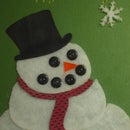Introduction: Make Adjustable Feet for a Butcher Block - Made at Techshop
Someone I know recently commisioned a cutting board from me - as described in my earlier instructable how to make an end grain cutting board. But instead of making a normal size cutting board, they wanted a full-on butcher block, and I decided that instead of just being a solid block, it needed some feet. I'm going to show you how I made a set of individually adjustable feet for this butcher block.
The feet aren't just aesthetic, in this case they were necessary. Unfortunately I chose to make this butcher block during a period of rapid weather change in San Francisco. In just one week the weather changed from cold, dry and wintery weather to warm, somewhat humid, spring weather - with several days of heavy rain thrown in for good measure.
I can only assume all these atmospheric hijinks wreaked havoc with this project. I started out with what seemed like very straight lumber, but after it was cut and glued, to my dismay the entire butcher block curled up like a potato chip (okay, slight exaggeration - but that's how it felt). The opposite corners on both sides of the board were twisted between 1/16" - 1/8" high, making the board rock from side to side.
With some serious hand-planing and sanding, I was able to get the board mostly flat, but I was worried it might not stay that way forever - especially since the customer will be taking it home to a very different climate. By adding some adjustable feet, I hope to future-proof this butcher block, allowing each foot to be adjusted to compensate for any future (hopefully small) warping.
Step 1: Why Make Feet for a Butcher Block?
- Feet are nice, and add a whole new design element to a cutting board. They can be simple and minimal (like mine), or they can be ornate, using interesting shapes or carvings. This looks especially good on cutting boards that are meant to sit out on the counter instead of being put away between uses.
- Sometimes a bit of moisture in the kitchen is unavoidable. But when one side of a cutting board (the top) is allowed to dry, while the other side (the bottom) absorbs moisture, it can be a recipe for warping. Feet help solve this problem by allowing air to circulate around the entire board, and lifting it above potentially wet countertops.
- If you have a slippery countertop, rubber feet can help grip the surface and keep the cutting board from moving.
- Whenever the seasons change, the humidity rises or falls, or you move to a new climate - the wood in a butcher block can shrink and expand, slightly changing its shape. If your cutting board develops this type of defect (like mine) adjustable feet can help save the board.
There are purpose-built leveling feet available, used for furniture, appliances and other househole objects. However I couldn't find any such hardware at my local hardware store, so I just browsed the aisles and looked for parts I could hack together. For anyone else making similar feet, there are good parts available online - look for leveling feet or anti-skid furniture legs. And while I decided to keep my legs simple, I'm sure there are lots of interesting designs out there.
Step 2: Materials and Tools
Materials used
- Walnut scrap
- Adjustable furniture glides
- Rubber pads
- Devcon epoxy
- Wood glue
- 16 wooden dowels
Tools used
- Miter saw
- Drill press
- Forstner bit (1 3/8/4") - drills perfect round holes with flat bottoms
- Drill bit (1/4") for wooden dowels and (7/32") for the furniture glides
- Mallet
- Sandpaper
Step 3: Make the Adjustable Feet
I started by assembling the adjustable feet.
First, I chose the height for my feet. I wanted the rubber part to be mostly covered by wood, with just a little bit peeking out, allowing the feet to be twisted for adjustment. I also needed the bolt from the furniture glides to stick out far enough to get a good grip in the wood. In the end, I made the feet 1 1/4" high with ~1/4" of the rubber sticking out.
To make this work, I put the furniture glides about halfway down inside the rubber feet. But I couldn't stop here, because when pressure was applied to the glides, they slipped even further down inside of the feet - I had to fill the space beneath with something So, before inserting the furniture glides, I squirted in some epoxy into each of the rubber feet. The epoxy fills the space beneath the furniture glides, ensuring they don't slip down further, and once dried locks the glides firmly in place.
Make sure that the glides are totally straight before the epoxy dries - if they are sticking into the rubber foot at an angle, it will be difficult or impossible to screw them into the butcher block later.
After ~30 minutes, the feet were all rock solid, so I moved onto the next phase - making legs to hide the rubber feet.
Step 4: Make & Mount Legs
To attach the legs I needed more than just glue, because gluing end-grain to end-grain can be problematic. End grain may look like a solid surface, but it's not. Think of the wood fibers (third picture), on the microscopic level, as a stack of drinking straws standing vertically - think of how hard it would be to glue the tips of the straws together - very little glue would hold them, and most of the glue would get sucked up inside the straws. This is exactly what happens with end grain - leading to much weaker joints than gluing face grain or edge grain.
To overcome this, I mounted the legs with wooden dowels plus wood glue, greatly increasing the strength of the joints.
Make the legs
- I cut the scrap walnut, measuring ~ 1 3/4" X 1 3/4", into blocks 1 1/4" thick. The end grain of the block will form the top and bottom of the legs.
- I also cut a thin piece of wood, ~1/4" thick, from the same scrap. I used this to make a drilling template, so that my drilling pattern for the dowels and feet in each block would be spaced correctly.
-
I used the template to align the drill-bits on each block, then drilled the holes with the blocks mounted in a vise on the drill press.
- First I drilled a large central hole for the feet with the 1 3/8" forstner bit, setting the drill press to stop drilling at 1" deep.
- Then I used a 7/32" drill bit to make a hole through the center of the larger hole. I used the divot left by the forstner bit as a guide for the center. This hole will hold the bolt on the furniture glides
- Finally, I used a 1/4" drill bit to make 4 holes for the dowels. I put the holes just outside the diameter of the large center hole for the legs, and drilled it half the length of the dowels.
Mounting the legs
- To mount the legs, I had to drill dowel holes in the bottom of the butcher block that perfectly matched the dowel holes in the legs. To locate the holes, I dipped the top of the legs in water, then pressed them against the corner of the butcher block. When I lifted the leg, impressions of the holes were left behind showing me where to drill.
- I used a hand-drill and carefully drilled straight holes in all corners of the block.
- Spread glue over the top of the legs and into the dowel holes on the legs and the block
- Insert dowels into the legs, then push the legs into the holes on the block. The legs may require light tapping with a mallet to fully seat.
Step 5: Install Feet & Adjust Height
Once all the legs are installed, slowly thread the bolt on the feet into the hole inside the legs. The 7/32" hole is just smaller than the bolts used for the feet - which allows the bolts to cut into the wood and make their own threads. Start by screwing all four feet as far as you can into the legs, then set the board down on a flat surface to test them out. If any of the corners are high, you can adjust the feet by twisting them in or out. Adjust the legs until the block is level.
That's it!
After making the feet, finish them using the same method as the rest of the butcher block. In my case, I had sanded the butcher block to 220 grit sandpaper, and planned to use plain mineral oil for finish. I followed this treatment with both the legs and body
After making the legs, finish them off using whatever method was used to finish the rest of the butcher block. In my case, I hand sanded the butcher block and legs up to 220 grit sandpaper and oiled the entire block with mineral oil.













